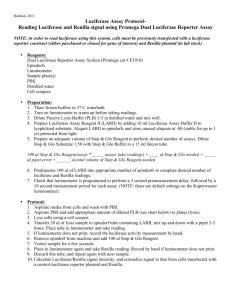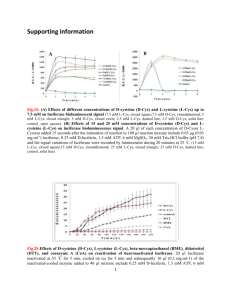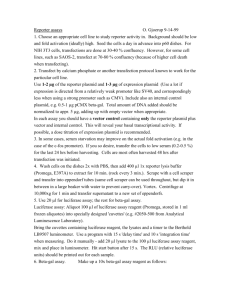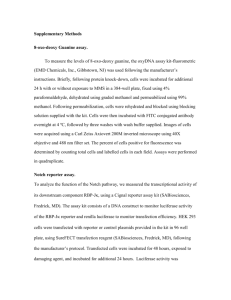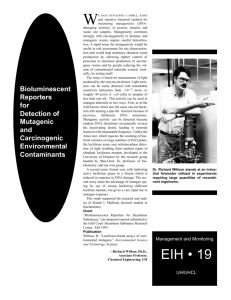University of Texas at San Antonio
advertisement
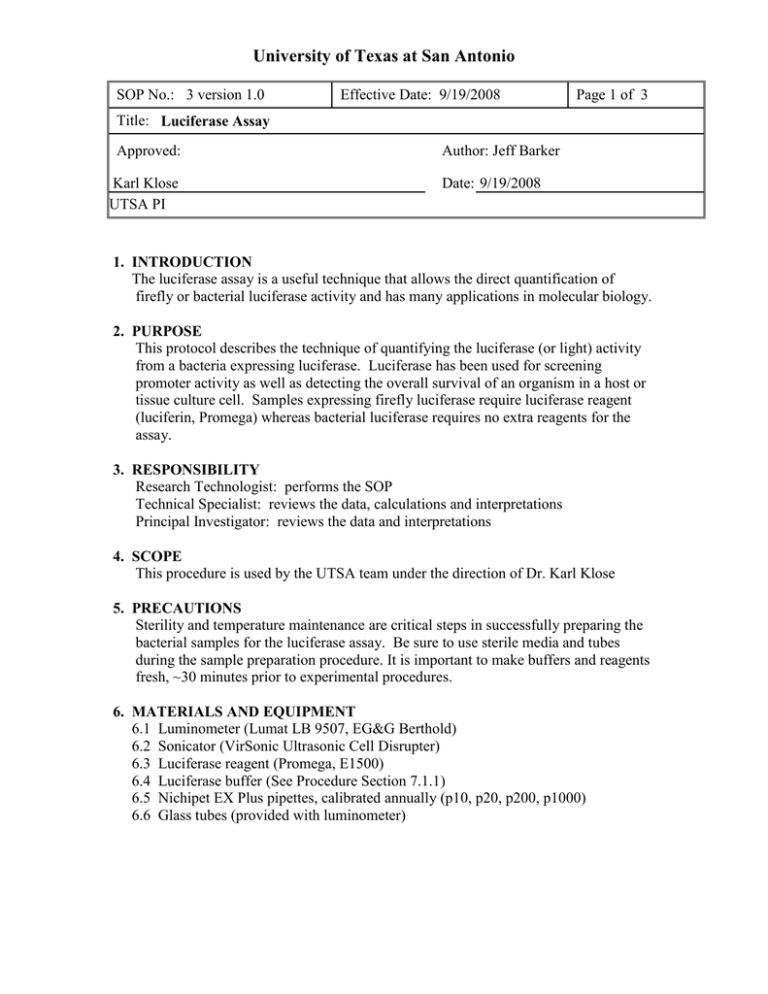
University of Texas at San Antonio SOP No.: 3 version 1.0 Effective Date: 9/19/2008 Page 1 of 3 Title: Luciferase Assay Approved: Karl Klose UTSA PI Author: Jeff Barker Date: 9/19/2008 1. INTRODUCTION The luciferase assay is a useful technique that allows the direct quantification of firefly or bacterial luciferase activity and has many applications in molecular biology. 2. PURPOSE This protocol describes the technique of quantifying the luciferase (or light) activity from a bacteria expressing luciferase. Luciferase has been used for screening promoter activity as well as detecting the overall survival of an organism in a host or tissue culture cell. Samples expressing firefly luciferase require luciferase reagent (luciferin, Promega) whereas bacterial luciferase requires no extra reagents for the assay. 3. RESPONSIBILITY Research Technologist: performs the SOP Technical Specialist: reviews the data, calculations and interpretations Principal Investigator: reviews the data and interpretations 4. SCOPE This procedure is used by the UTSA team under the direction of Dr. Karl Klose 5. PRECAUTIONS Sterility and temperature maintenance are critical steps in successfully preparing the bacterial samples for the luciferase assay. Be sure to use sterile media and tubes during the sample preparation procedure. It is important to make buffers and reagents fresh, ~30 minutes prior to experimental procedures. 6. MATERIALS AND EQUIPMENT 6.1 Luminometer (Lumat LB 9507, EG&G Berthold) 6.2 Sonicator (VirSonic Ultrasonic Cell Disrupter) 6.3 Luciferase reagent (Promega, E1500) 6.4 Luciferase buffer (See Procedure Section 7.1.1) 6.5 Nichipet EX Plus pipettes, calibrated annually (p10, p20, p200, p1000) 6.6 Glass tubes (provided with luminometer) University of Texas at San Antonio SOP No.: 3 version 1.0 Effective Date: 9/19/2008 Page 2 of 3 Title: Luciferase Assay Approved: Author: Jeff Barker Karl Klose UTSA PI Date: 9/19/2008 7. PROCEDURE 7.1 Reagent Preparation 7.1.1 1X Luciferase Buffer (25mM Tris, 2mM DTT, 2mM EDTA, 10% glycerol, 1% TritonX-100) 1.25 ml of 1 M Tris 100 ul of 1 M DTT 200 ul of 0.5 M EDTA 5 ml of 10% Glycerol (or 6.25 ml 80%) 0.5 ml 100% TritonX-100 Bring up to 50ml with H2O, store at 4ºC in 50 ml Conical Tube 7.2 Preparation of samples 7.2.1 Grow up 1 ml of Bacteria culture overnight from a colony on a plate, use LB to grow E. coli and TSB for Francisella cultures 7.2.2 Take 100 ul of overnight and put into 900 ul of fresh media and let grow 3 hours to log phase 7.2.3 Take 100 ul from log phase (OD600 of ~0.8) culture and put into 900 ul of 1X luciferase buffer 7.2.4 Sonicate for 15 seconds (Samples can be frozen at -20ºC at this point or assayed immediately) 7.2.5 Take out luciferase reagent from -80C freezer to thaw at room temperature and use immediately. 7.2.6 Assay 10 ul from sonicated cells in luminometer 7.3 Luminometer Operation (procedure will vary depending on equipment model) 7.3.1 Turn on machine 7.3.2 Unload water from reservoir 7.3.3 Replace water bottle with substrate bottle (Promega luciferin) 7.3.4 Prime machine with substrate 7.3.5 Measure luciferase activity by adding glass tube containing sample to the luminometer. Acceptable read out of sample is any reading that is significantly over your negative control. In general, anything over 100 is considered positive. Units will be given as RLU (reactive light units). 7.3.6 Unload substrate University of Texas at San Antonio SOP No.: 3 version 1.0 Effective Date: 9/19/2008 Page 3 of 3 Title: Luciferase Assay Approved: Author: Jeff Barker Karl Klose UTSA PI 7.3.7 Date: 9/19/2008 Switch Substrate for water and wash the line 2x with water to clear the tubing of substrate 8. QUALITY CONTROL Temperatures of incubators are noted with each usage Luminometer is calibrated and serviced annually (this is quality assurance) Pipettes are calibrated annually (this is quality assurance) 9. REFERENCES None 10. CALCULATIONS AND FORMULAS RLU/ml/ODU are calculated thus: The value obtained from the luminometer (reactive light units, RLU) is divided by the volume (ml) of culture added to the luminometer tube, divided by the OD (optical density) of the bacterial culture. Thus, volumes of culture (ml) added and growth phase (OD) of the culture are incorporated into the RLU (luciferase) data. 11. GLOSSARY ml- milliliter ul- micro liter cm- centimeter C- centigrade LB- Luria broth TSB- Tryptic Soy Broth 12. APPENDICES None

